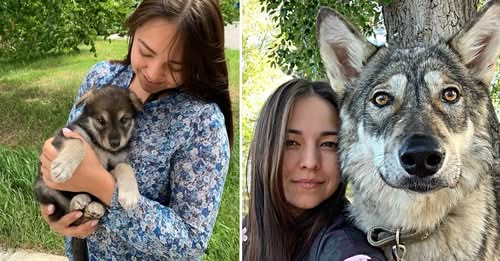Kira, a small wolf pup, had been abandoned in the woods, left to fend for herself. Alone and frightened, she wandered through the underbrush, her tiny frame shivering from the cold. Fortunately, fate intervened when a kind-hearted woman named Sarah stumbled upon her during a hike. Seeing the helpless pup, Sarah’s heart melted, and she knew she had to act.
Without hesitation, Sarah scooped up Kira and took her home, determined to provide the love and care the little wolf deserved. She prepared a warm bed, nutritious food, and a safe space for Kira to grow. From that moment on, Sarah became not only Kira’s caretaker but also her protector and best friend.
As weeks turned into months, Kira thrived in her new environment. Sarah spent countless hours nurturing her, teaching her how to play and interact with the world around her. They explored the nearby woods together, where Kira learned to embrace her wild instincts while feeling secure in Sarah’s presence.
Their bond deepened with each passing day. Kira would follow Sarah everywhere, her playful spirit shining as she bounded through the grass, her wolfish howl echoing in the air. They formed an unbreakable connection, one that transcended the boundaries between human and animal.
However, as Kira grew, challenges began to arise. People in the community were wary of a wolf living among them, worried about safety. Sarah faced scrutiny and judgment, but she refused to give up on Kira. She believed in her heart that Kira was more than just a wild animal; she was family.
To help bridge the gap between Kira and the community, Sarah began taking her to training classes designed for large breeds. With patience and dedication, Kira learned commands, socialization skills, and how to behave around other dogs and people. Each success reinforced Sarah’s belief that Kira could be a loving companion and not a threat.
As Kira matured, she became a beautiful wolf with striking features and a gentle demeanor. Her playful spirit remained, and she loved to show off her tricks during community events, often drawing crowds of curious onlookers. Slowly but surely, the community began to see Kira in a new light—not just as a wolf, but as a loving creature who had been given a second chance.
One summer day, Sarah organized a community gathering at a local park, inviting everyone to meet Kira. With a mix of excitement and nervousness, she hoped this event would help change perceptions. As families arrived, Kira greeted them with her charming personality, wagging her tail and accepting gentle pets.
The transformation was remarkable. People began to understand that Kira was not only safe but also a source of joy. Children laughed as she played, and parents appreciated her gentle nature. By the end of the day, many had warmed to her, and Sarah felt a sense of relief and happiness.
Kira’s story continued to inspire others, leading to a growing interest in wildlife conservation and the importance of understanding and protecting wild animals. Sarah became an advocate, educating her community about the beauty and complexity of wolves, emphasizing the need for compassion and respect.
As the seasons changed, Kira thrived, embodying the spirit of resilience and love. She and Sarah became inseparable, navigating life’s challenges together. They shared countless adventures, from hiking in the mountains to cozy nights by the fireplace, always reminding each other of the bond that had saved them both.
In the end, Kira was not just a wolf; she was a symbol of hope, proving that love can bridge even the widest chasms. Together, Sarah and Kira showed the world that family comes in many forms, and sometimes, it takes a little courage and compassion to create a beautiful life together.
